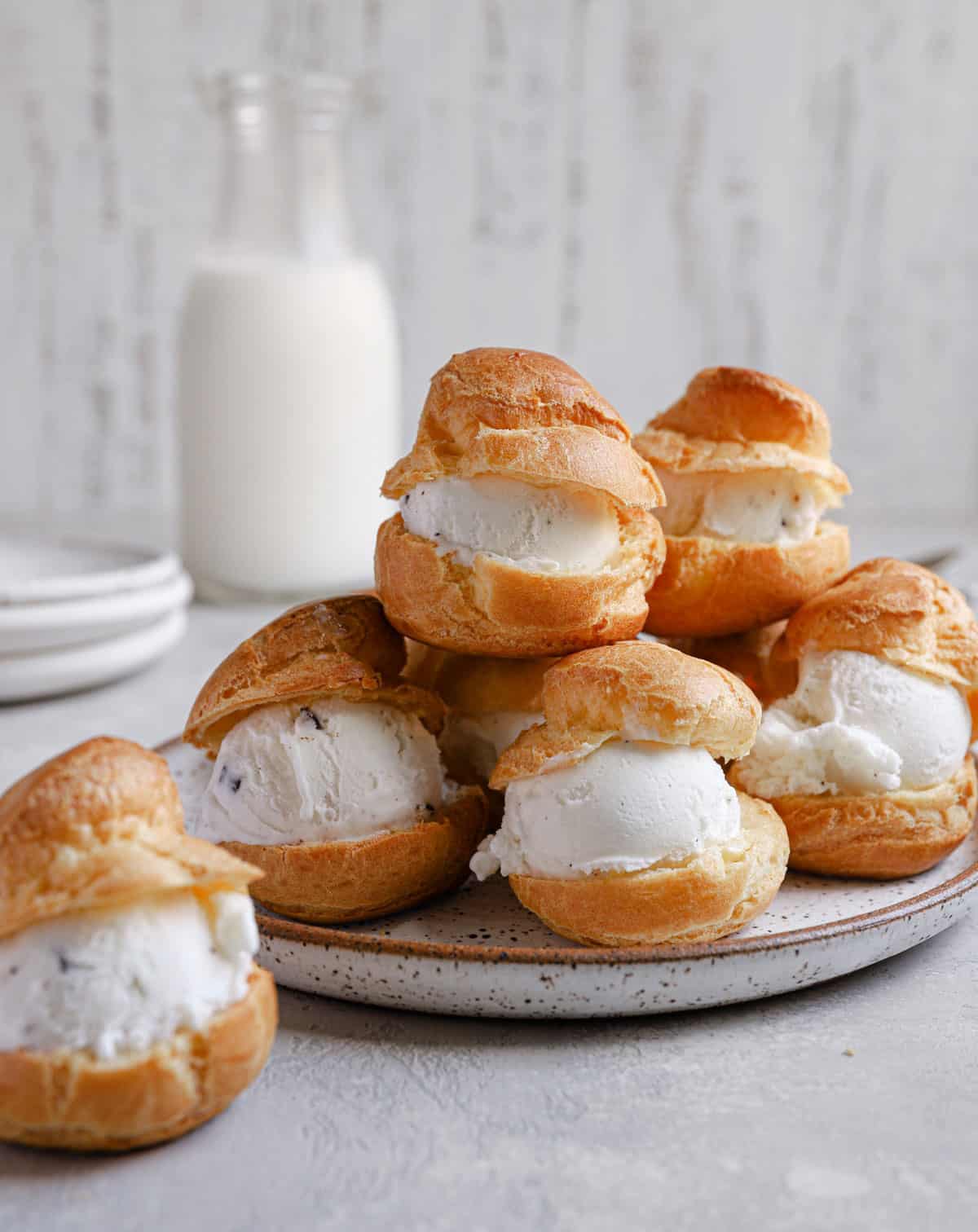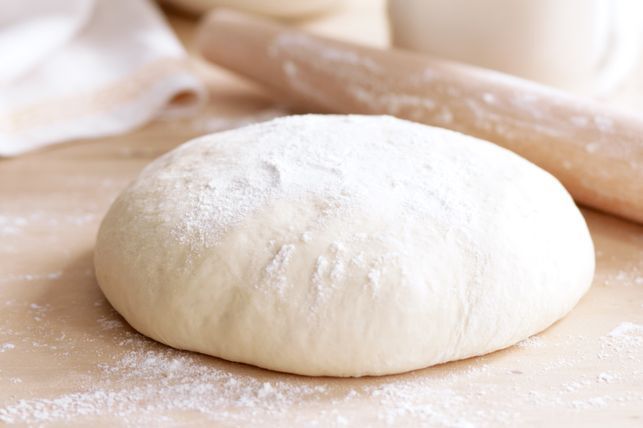Pâtes - Dough - Dej 🥨
"Des pâtes, des pâtes, oui mais des Panzani": collection of dough recipes for all sorts of dishes.

Introduction
This is reminder for basic dough recipes, taken from the book On va déguster la France[1].
Pâte brisée

Gluten-free and dairy-free
- 220g of gluten free flour. See below
- 5 tbsp olive oil
- 2 pinches of salt
- 2 or 3 tbs water
With gluten and dairy products
- 250g flour
- 2 pinches of salt
- 125g soft butter
- 2 or 3 tbs water
First mix flour, salt and butter. Once a coarse semolina is obtained, add the water and shape into a ball.
Pâte feuilletée

This dough is characterized by the way the fat is incorporated. There are two distinct elements:
- Tempera (détrempe): water + flour + salt
- Fat: butter or butter + flour (feuilletage inversé)
Pâte feuilletée traditionnelle
Butter is enveloped by the tempera, before making 5 ot 6 simple rounds (3-fold) or 4 double rounds (4-fold).
- Tempera: 500g flour + 250g water + 375g butter + 10g salt
- Rounding Fat (beurre de tourage): 500g
Pâte feuilletée inversée
It is lighter and more crumbly than the traditional version. Here, the tempera is enveloped in handled butter (beurre manié) (butter + flour), before making 5 rounds.
- Tempera: 350g flour + 175g water + 15g salt
- Handled butter: 15g flour + 400g butter
Pâte levée feuilletée
It's the one used to make croissants, pain au chocolat or brioche feuilletée. Teh tempera contains baker's yeast, milk, fat and sometimes eggs depending on the use.
3 rounds are typically made.
Pâte à choux

From chef Christophe Michalak
Ingredients
- 75g water
- 75g whole milk
- 3g caster sugar (sucre en poudre)
- 3g salt
- 65g butter
- 80g flour
- 145g whole eggs (about 3 small eggs)
Preparation
- Pre-heat the oven at 210C
- Mix water, milk, sugar, salt and butter in a pot and bring to boil
- Add flour all at once and mix over the heat until the texture becomes homogeneous: that's what we call to dry the dough (dessécher la pâte). It must stick to the sides of the pot
- Pour into a bowl and add the eggs one by one with a wooden spoon until a "bird's beak" (bec d'oiseau) is obtained: the dough must form a rather firm point, like the beak of a bird.
- Put in a piping bag (poche à douille) of the desired width for your choux, and create choux of the desired size on some baking paper
- Put in the oven, turn off the oven, and let it bake like this for 10 min
- Turn the oven back on at 150C and continue baking for 25 min
Pâte à pizza

Ingredients
- 500g flour typo 00 (w260) or T45
- 300-320g water at room temperature
- 5g fresh baker's yeast
- 10-12g fine salt
Preparation
- Place flour and crumbled yeast onto a flat surface
- Pour 3/4 of the water in a trickle (en filet)
- Knead the dough until a coarse dough is obtained
- Add the salt by pinches and the rest of the water in a trickle
- Knead the dough for 15 min (in a salad bowl or on the flat surface) until a slick dough, homogeneous and elastic is obtained. It must stick on the surface
- Shape it into a ball and put aside in a salad bown capable of containing 3 times its size
- Put a plastic film on and let is grow for 4 hours at a temperature of about 18C, protected from air drafts
- Divide the ball into balls of 280g each, and put them on a plate with high edges, spacing them enough as they will continue growing.
- Put a plastic film on (without smashing the balls) and let things grow for 4 more hours at a temperature of around 18C, protected from air dragts
- Spread the dough with your hands, place them onto an oil metallic plate
- Add the toppings
Pizza cooking: 12-15 min in an oven pre-heated at 230-250C
Gluten/nut/dairy-free flour
Gluten-free flour have quite distinct textures and taste: it is recommended to mix either 2 different ones together with a starch (fécule) which will help bind and add volume, and another binding agent, in a 4:2:1 ratio [2].
There are different ways to classify flours [3][4]. One could distinguish between:
Low-proteine, light taste flours
- Rice flour (riz, ris)
- Millet flour (millet, hirse)
- Quinoa flour (quinoa, quinoa)
- Hemp flour (chanvre, hamp)
Low-proteine, strong taste flours
- Buckwheat flour (sarrasin, boghvede)
- Amaranth flour (amarante, amarant)
- Teff flour (teff, teff)
High-proteine, strong taste flours
- Soy flour (soja, soj)
- Chickpea flour (pois chiche, kikært)
- Lentil flour (lentilles, lentil)
Starch (amidon et fécule)
- Corn starch (mais, mais)
- Tapioca starch (tapioca, tapioca)
- Potato starch (pomme de terre, kartoffel)
- Arrowroot (marante, pilrod)
And many others.
Binding agents
Can be interchangeably:
- Guar gum
- Xanthan gum
- Agar agar
- Flax gains (lin, hør) or chia grains, ground and mixed with water
Examples
220g flour for pâte brisée:
- 100g rice flour
- 50g millet or buckwheat flour
- 50g corn starch
- 1 tsp guar gum
References
François-Régis Gaudry (2017), On va déguster la France. https://www.radiofrance.com/les-editions/livre/va-deguster-la-france ↩︎
Nu3, Les farines sans gluten, https://www.nu3.fr/blogs/food-trends/farines-sans-gluten ↩︎
Valpibio, Les farines sans gluten sont nombreuses, comment les utiliser?, https://www.valpibio.com/au-quotidien/les-farines-sans-gluten/ ↩︎
Au vert avec Lili, Sans gluten c'est facile, https://auvertaveclili.fr/sans-gluten-cest-facile/ ↩︎
